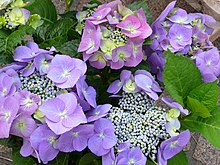
Back Hydrangea Afrikaans كوبية (نبات) Arabic هدرانج ARZ Hortenziya Azerbaijani Гартэнзія Byelorussian Хортензия (род) Bulgarian হাইড্রেনজিয়া Bengali/Bangla དྲང་སོང་མེ་ཏོག Tibetan Roz-kaouled Breton Hydrangea Catalan
| Hydrangea | |
|---|---|

| |
| Hydrangea macrophylla | |
| Scientific classification | |
| Kingdom: | Plantae |
| Clade: | Tracheophytes |
| Clade: | Angiosperms |
| Clade: | Eudicots |
| Clade: | Asterids |
| Order: | Cornales |
| Family: | Hydrangeaceae |
| Genus: | Hydrangea Gronov. ex L. |
| Type species | |
| Hydrangea arborescens L.[1] | |
| Species | |
|
See text | |
| Synonyms[2] | |
|
synonymy
| |
Hydrangea (/haɪˈdreɪndʒiə/),[3] commonly named the hortensia, is a genus of more than 70 species of flowering plants native to Asia and the Americas. By far the greatest species diversity is in eastern Asia, notably China, Korea, and Japan. Most are shrubs 1–3 m (3 ft 3 in – 9 ft 10 in) tall, but some are small trees, and others lianas reaching up to 30 m (100 ft) by climbing up trees. They can be either deciduous or evergreen, though the widely cultivated temperate species are all deciduous.[4]
The flowers of many hydrangea act as natural pH indicators, sporting blue flowers when the soil is acidic and pink ones when the soil is alkaline.
- ^ Hydrangea | International Plant Names Index. (n.d.). Retrieved January 5, 2024, from https://www.ipni.org/n/30010546-2
- ^ "Hydrangea Gronov. ex L." Plants of the World Online. Board of Trustees of the Royal Botanic Gardens, Kew. 2021. Retrieved 17 September 2021.
- ^ Sunset Western Garden Book, 1995:606–607
- ^ "The United States National Arboretum: Hydrangea FAQ". Archived from the original on 16 May 2013. Retrieved 27 November 2008.
© MMXXIII Rich X Search. We shall prevail. All rights reserved. Rich X Search